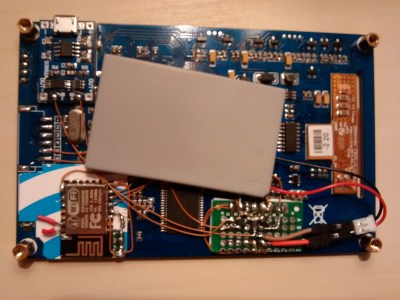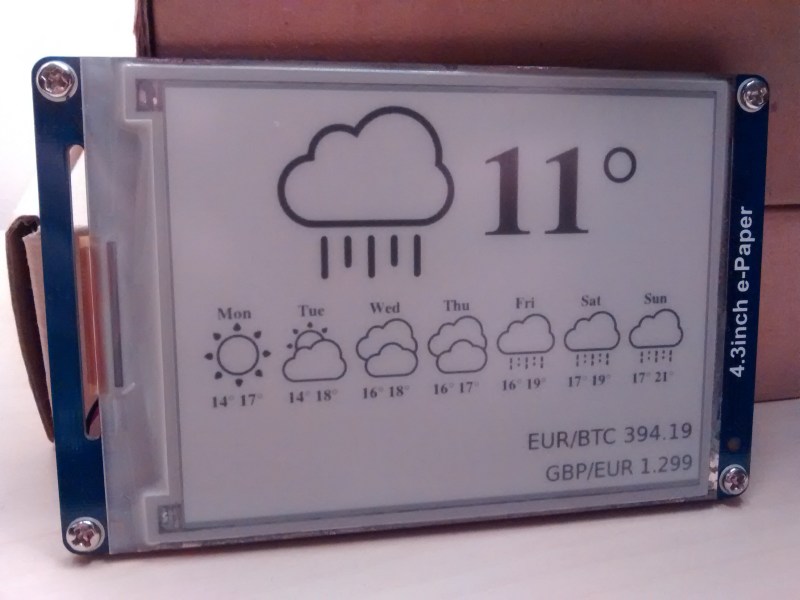[David] created a great looking e-ink WiFi display project that works a little like a network-connected picture frame with a few improvements over other similar projects. With the help of an ESP8266 it boots up, grabs an 800×600 image over the network, updates the screen, then goes back to sleep. Thanks to some reverse engineering, he was able to make his own firmware for the onboard controller to handle the low-level driving of the display. Since e-ink displays require no power to hold an image and the rest of the unit spends most of the time either asleep or off, power use is extremely low. [David] hopes to go months without needing to recharge the internal lithium-polymer battery.

We previously featured another WiFi-connected e-ink display project that was in fact also the inspiration for this version. [David] uses a 4.3″ 800×600 GDE043A e-ink display and wrote his own firmware for the STM32F103ZE ARM CortexM3 SoC used as a display controller, a process that required some reverse engineering but was aided by the manufacturer providing a closed-source driver for him to use. [David] writes that some reverse-engineering work for this display had already been done, but he had such a hard time getting a clear understanding from it that he reverse engineered the firmware anyway and used the documents mainly for validation and guidance.
As a result, [David] was able to make use of the low-level driver electronics already present on the board instead of having to make and interface his own. E-ink displays have some unusual driving requirements which include generating relatively high positive and negative voltages, and rapidly switching them when updating the display. Taking advantage of the board’s existing low-level driver electronics was a big benefit.
 The ESP8266 rounds out the project by taking care of periodically booting things up, connecting to the wireless network and downloading an image, feeding the image data to the STM32 to update the display, then disconnecting power from all non-essential electronics and going back to sleep. We especially like how the unit automatically creates a WiFi access point to allow easy (re)configuring.
The ESP8266 rounds out the project by taking care of periodically booting things up, connecting to the wireless network and downloading an image, feeding the image data to the STM32 to update the display, then disconnecting power from all non-essential electronics and going back to sleep. We especially like how the unit automatically creates a WiFi access point to allow easy (re)configuring.
There’s one more nice touch. [David] goes the extra mile with server software (in the form of PHP scripts) to design screens for the display with data like weather forecasts, stock prices, and exchange rates. Check it out in the project’s github repository.
















I considered doing something like this but ended up hacking a used Kindle e-reader. Bigger display, very cheap on eBay, and plenty of places on the web with instructions for how to do it.
And like everyone else, I made a weather display out of it.
[Slow clap.] Yes the cost makes that approach more appealing. Wish the displays were cheaper.
BGMicro occasionally has them. I bought two at ~$2/ea
The Kindle ones, that is, not the ones in the article.
I bought this same display and was really disappointed with the default firmware’s capabilities. This should give me a great head start to the project I want to finish.
Love this project ! I don’t understand why there is still no large Wifi E-Ink display.. it’s so coool !
And people still need stong knowledge to hack Alibaba E-Ink display or workaround closed Amazon Kindle …
Hope a product like this one will come to life :-)
Look up Sony DPT. 13.3″ screen with Wacom sensors and touch.
800$ that’s a little bit hard ;-)
ESL with epaper have all you need: Display, Wireless, Low Power and Cheap.
Needs only someone to hack it.
Ditto. Begging for a large e-ink “connected” display. I hacked a kindle and it was “OK” but surely there’s plenty of demand. If I had the time… kickstarter is crying out :)
Ever been in a Kohl’s Department store? Every price tag in the store is a WiFi connected e-Paper display.
We are doing something somewhat like this but in a more consumer friendly package. We are thinking about launching an SDK – any thoughts on an app you would want to say? https://flair.co/products/puck
Have you had any problems (legal or otherwise) with potential confusion with the Nest devices?
Probably fewer problems than Nest had regarding the original Honeywell stats they copied.
Nope. And as Jim Beam said, it would be pretty silly given their run in with Honeywell.
It’s so big. Are there flush mount accessories?
What do you mean its so big? The Puck. Its actually pretty small – 60mm in diameter.
But yeah, it does flush mount to a wall if you want. The stand you see in some of the images flips around and acts as a magnetic mounting plate.
What is the size for this device ? It seems very small indeed. If you offer a SDK, at least as a way for to push images to the device from a server (or better, let the device ask for images with a predefined interval or conditions).
I think it could be a great idea to power and charge a battery for a smart watch. The thing that I dread about a smart watch is having to plug in another device at night and make sure I have two cords for both when I need it. It would be great if at some point (when a smart watch becomes a useful device), that one could just plug in the phone to charge and set the watch on the phone and have it charge it with the NFC during the night…
i really wish people would rather seek some solution to using those cheap e-ink price-tags from china
how long will it last on this battery?